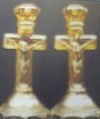Carnival Glass 101 | home Quick Reference to Carnival Glass Patterns on This Site
Dugan - Diamond - Part 5
Dugan - Diamond - Part 5
Thomas Dugan (cousin to Harry Northwood and previous employee of Hobbs, Brockunier & Company) moved to Buckeye Glass, which had opened in 1878, then became manager of the Indiana, PA plant for National, after it joined with Northwood. In 1904, he purchased the Indiana, PA plant from National, and started Dugan Glass Company. It began producing opalescent glass right away but discontinued it after 1910 in favor of iridescent glass. In 1913 Thomas Dugan resigned from the firm and the company was renamed Diamond Glass Company. Diamond remained in business till 1931, when the plant was destroyed by fire.
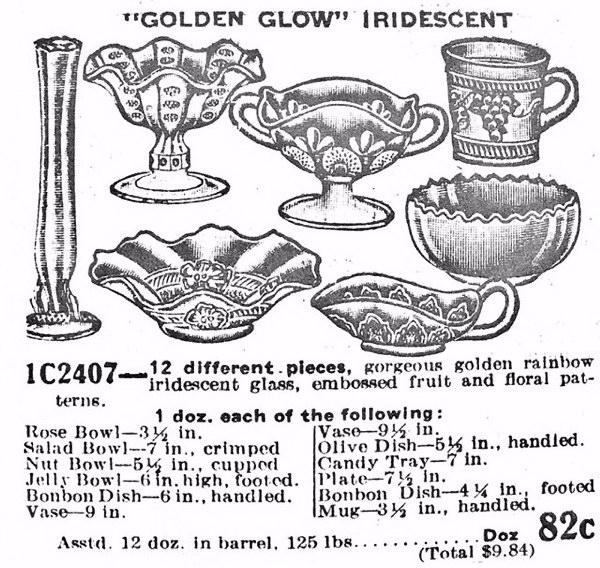
April 1929 Butler Bros. Wholesale Catalog.
(NOTE - round openings in stem of compote).
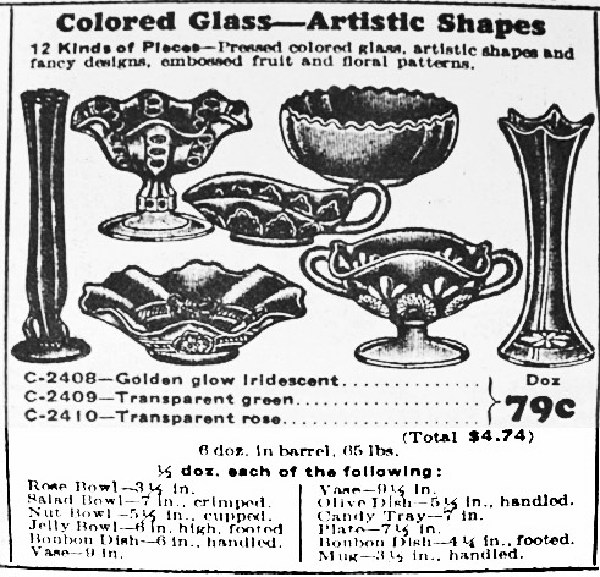
April 1931 Butler Bros. Wholesale Catalog.
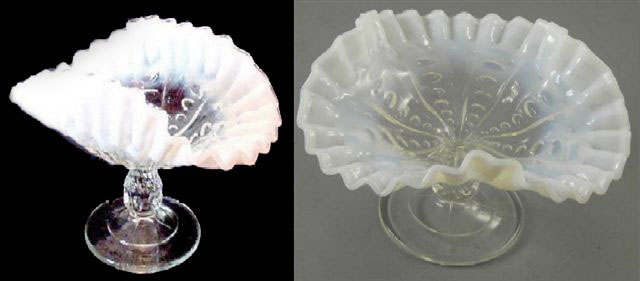
COIN SPOT Callled BUCKEYE & CONCAVE COLUMNS in Opalescent Glass.
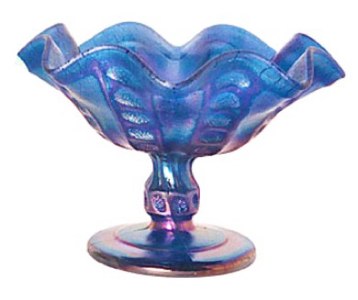
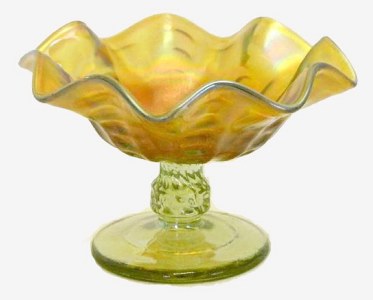
COIN SPOT Compotes - Cobalt Blue and Lime Green.
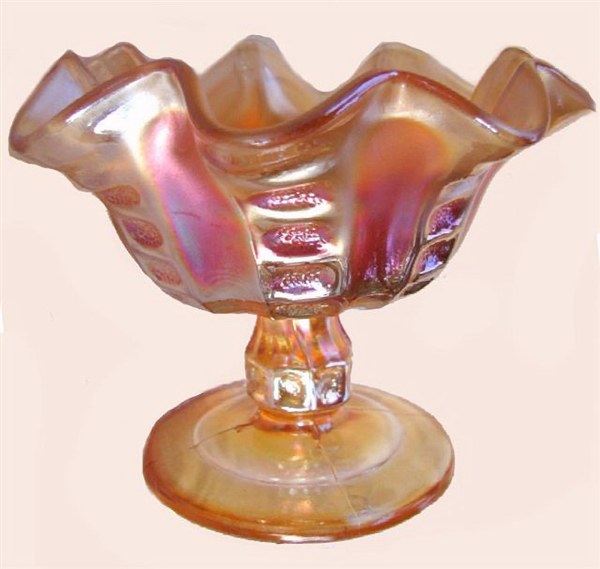
COIN SPOT Compote displaying indentations surrounding the stem - Marigold.
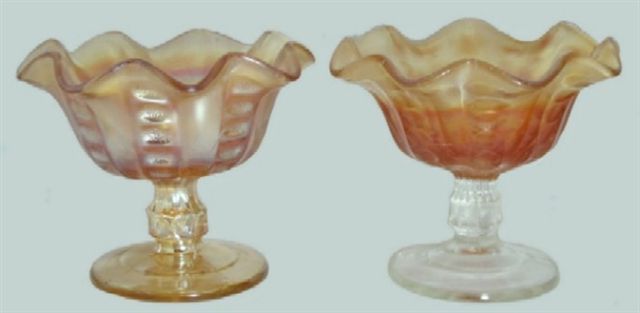
Differing Stems (COIN SPOT) - 6 in. diam. x 4.25 in.high.
Courtesy Samantha Prince
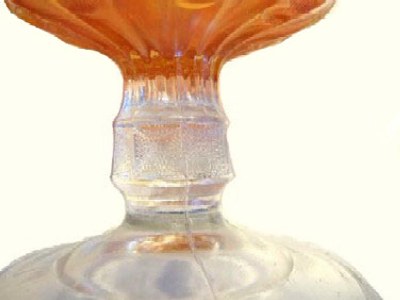
COIN SPOT - Clear glass stem with stippling.
Courtesy Samantha Prince
COIN SPOT (Opalescent): Apparently, this was one of the earliest moulds for production of opalescent glass, (1905); and carried over into the iridescent era! Close examination of the stem, indicates small indentations at intervals. The pattern names: BUCKEYE & CONCAVE COLUMNS are listed in a book titled The Story of Indiana, Pennsylvania. Opalescent novelties were advertised in a full-page ad of the China, Glass and Lamps in Jan.1908, mentioning five new patterns and eight creatively titled assortments.1929 and1931 Butler Bros.Wholesale ads display carnival patterns available included the Coin Spot compote. Examples appeared in wholesale catalogs as part of the Diamond Golden Glow assortment. It is logical to assume that use of any mould spanning a period of more than 25 years would require repair, if not replacement.
The alterations observed in the mould originally having indentations to the one seen with those tiny openings closed and covered with stippling, lead to possibility that the original mould openings became damaged with use over time, and were filled in repair, then stippling was applied. We know that stippling was applied to many moulds in order to cover damage which had occurred over long production periods. (Many collectors place high value upon ownership of stippled pieces of carnival glass, but that stippling signifies a later production period.)
The iridized stem has square openings. The non-iridized stem has round/oval openings. An iridized cobalt blue compote is shown in Dugan/Diamond-The Story of Indiana, Pennsylvania Glass by Heacock, Measell, Wiggins, circa 1993. It “appears” to have the round/oval stem openings.
One compote in Aqua Opal is known. Marigold, amber, amethyst, peach opal, cobalt blue, lime green, celeste, ice green, and pink examples in the Coin Spot pattern have sold at auction in recent years. The pink Depression glass example which sold in 2011 brought $115!

PEACH & PEAR as advertised in the
Spring & Summer issue -1923 Montgomery Ward Catalog.
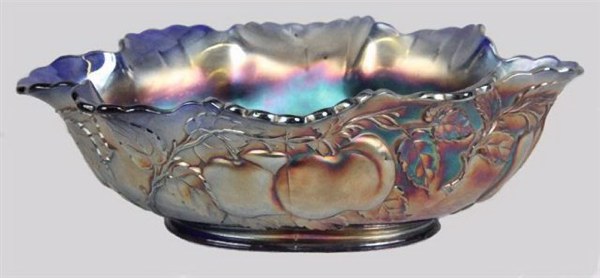
PEACH and PEAR in BLUE!
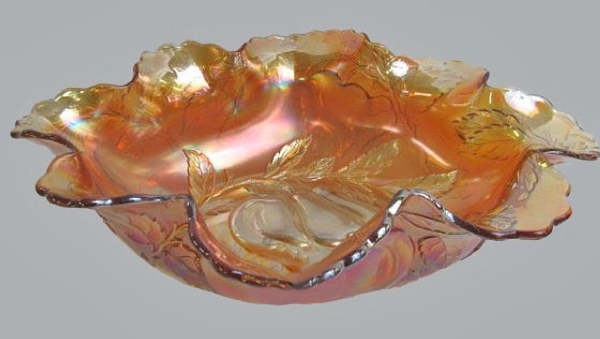
PEACH and PEAR Banana Boat in Marigold.
PEACH & PEAR: This pattern from the Diamond Glass era (1913-1931) is not often seen. The banana boat shape is 12”-13” long. Depending upon the edge flare, they can be 7”-9” in width. The pears are grouped on the inside bottom of the oval shaped bowl. Peaches (or apples?) are seen on the exterior. Amethyst bowls are fewer in number than marigold, but the quality of iridescence can vary greatly. A blue bowl sold on eBay in 2005 for less than $200!
Dean & Diane Fry, Feb. 2014





Now Godliness with contentment is great gain.
For we brought nothing into this world, and it is certain we can carry nothing out.
And having food and clothing, with these we shall be content.
But those who desire to be rich fall into temptation and a snare,
and into many foolish and harmful lusts which drown men in destruction and perdition.
For the love of money is a root of all kinds of evil,
for which some have strayed from the faith in their greediness,
and pierced themselves through with many sorrows.
But you, O man of God, flee these things and pursue righteousness,
godliness, faith, love, patience, gentleness.
Fight the good fight of faith, lay hold on eternal life,
to which you were also called and have confessed the good confession
in the presence of many witnesses.
(1 Timothy 6:6-12)





Should you care to contact the Frys, their email address is:
Search Carnival Glass 101
back to Carnival Glass 101
Our other sites you may enjoy:
Everything you EVER wanted to know about Indiana Glass
Great Reference for Newer Carnival Glass.
Complete Glassware Catalogs Available to Download
Questions? Comments? Suggestions? Broken Links? Corrections?
Your Friendly Webmaster is here to help!
